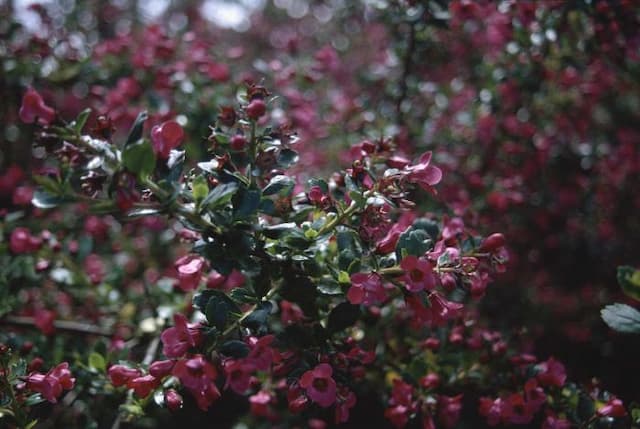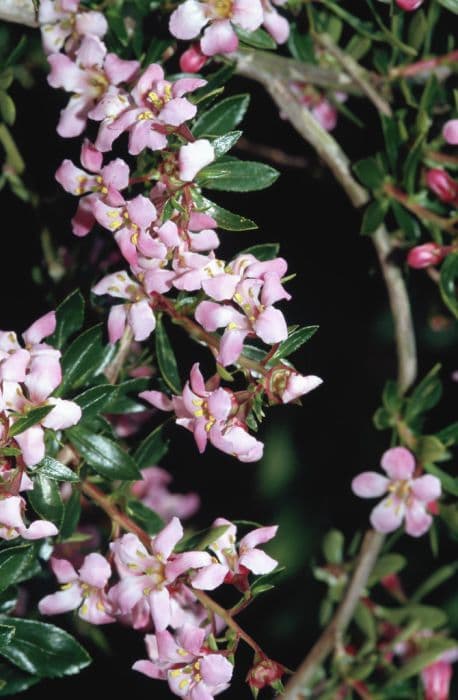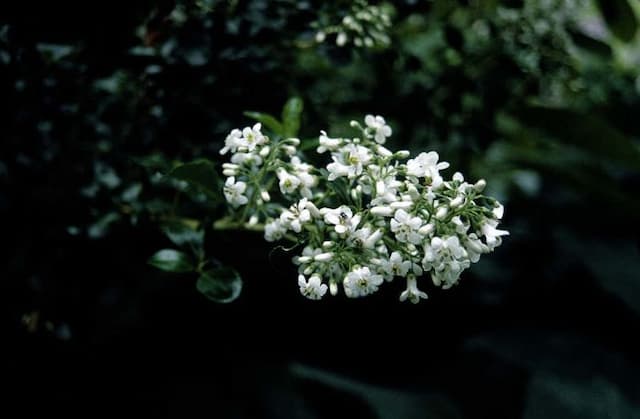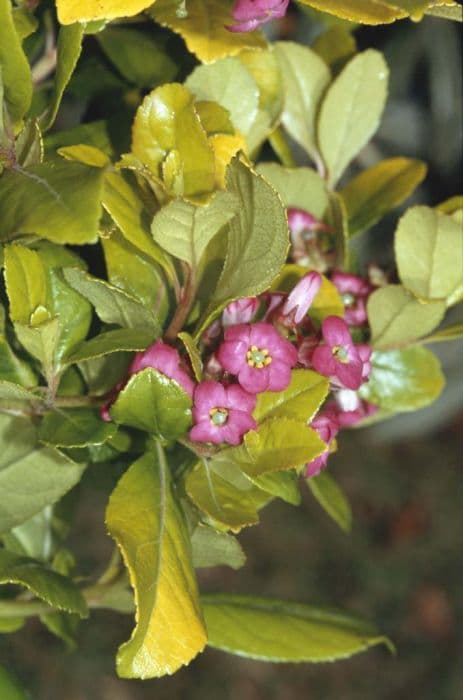Red Escallonia Escallonia rubra var. macrantha

ABOUT
The plant known commonly as Red Escallonia is characterized by its notable glossy, dark green leaves that are small, oval-shaped, and pointed at the tips, creating an evergreen backdrop throughout the year. The foliage, dense and leathery, can serve as a lush and hardy hedge or screen in gardens. In full bloom, this shrub exhibits a profusion of small, trumpet-shaped flowers in striking shades of red or pink that form in clusters at the ends of the branches. These vibrantly colored flowers are attractive to various pollinators, including bees and butterflies, which find them particularly appealing. The bright blooms contrast beautifully with the foliage and can be seen ornamenting the plant for a long time from late spring to early autumn, adding long-lasting interest to outdoor spaces. The Red Escallonia, with its combination of decorative leaves and eye-catching flowers, is often used in ornamental gardening for its aesthetic appeal and low maintenance qualities, providing vibrant color and lushness to landscapes.
About this plant
 Names
NamesFamily
Escalloniaceae.
Synonyms
Red Escallonia, Red-Flowered Escallonia.
Common names
Escallonia macrantha Hook. & Arn., Escallonia poeppigii Hutch., Escallonia rubra var. macrantha (Hook. & Arn.) Reiche.
 Toxicity
ToxicityTo humans
Escallonia is not commonly listed as a toxic plant to humans, and there is limited information about its toxicity. However, like many garden plants, it may cause irritation or an allergic reaction if ingested or if the sap comes into contact with the skin of sensitive individuals. It's always best to handle plants with care and avoid ingesting any plant material unless it is known to be safe for human consumption.
To pets
Escallonia is not commonly known to be toxic to pets, but as with most plants not intended for pet consumption, it is prudent to prevent pets from ingesting the plant. There is no well-documented toxicity in the common literature concerning pets, but if you suspect your pet has ingested Escallonia and is showing signs of illness, it is advisable to contact a veterinarian. Typical signs of plant poisoning can include vomiting, diarrhea, drooling, or changes in behavior.
 Characteristics
CharacteristicsLife cycle
Perennials
Foliage type
Evergreen
Color of leaves
Green
Flower color
Pink
Height
10-15 feet (3-4.5 meters)
Spread
6-8 feet (1.8-2.4 meters)
Plant type
Shrub
Hardiness zones
8
Native area
South America
Benefits
 General Benefits
General Benefits- Ornamental Appeal: Escallonia macrantha features attractive glossy green foliage and vibrant red flowers that can enhance the aesthetic of gardens and landscapes.
- Wildlife Attraction: The plant's flowers are a nectar source for bees, butterflies, and other pollinators, supporting local biodiversity.
- Hedging and Screening: Due to its dense growth habit, it is often used for creating privacy hedges and windbreaks.
- Coastal Tolerance: It is particularly suited to coastal areas as it can withstand salt spray, making it ideal for seaside gardens.
- Low Maintenance: Escallonia macrantha requires minimal upkeep once established, with only occasional pruning to maintain shape and size.
- Drought Resistance: The plant is quite drought-tolerant, making it suitable for regions with dry climates or for water-wise gardening practices.
- Adaptability: It adapts well to a range of soil types, although it prefers well-drained conditions.
- Evergreen Foliage: As an evergreen, it provides year-round color and structure to the garden, even in the winter months.
 Medical Properties
Medical PropertiesThis plant is not used for medical purposes.
 Air-purifying Qualities
Air-purifying QualitiesThis plant is not specifically known for air purifying qualities.
 Other Uses
Other Uses- Escallonia rubra var. macrantha, commonly known as Red Escallonia, can be used as a natural barrier or hedge due to its dense foliage, offering privacy and wind protection for gardens.
- The plant is suitable for coastal landscaping as it tolerates salt spray and can contribute to stabilizing slopes and preventing erosion in seaside environments.
- Its fast-growing and adaptable nature makes it an excellent choice for urban planting, contributing to the urban greenery and providing shelter for wildlife.
- Red Escallonia's vibrant flowers can be used as a natural food dye, adding a splash of color to culinary presentations.
- The wood of Red Escallonia, being sturdy and of moderate density, can be utilized in the making of small wooden tools or handles.
- Red Escallonia is ideal for topiary or formal garden design due to its responsiveness to pruning and shaping.
- Due to its attractively glossy leaves, branches of Red Escallonia can be clipped and used in floral arrangements for added greenery.
- The plant can be used in noise pollution reduction, as its dense growth can absorb and diminish sound levels in busy areas.
- Red Escallonia, when planted in mass, can support beneficial insect populations, such as bees and butterflies, helping to sustain local ecosystems.
- Its robust character makes it a potential candidate for phytoremediation projects where plants are used to stabilize and rehabilitate contaminated soils.
Interesting Facts
 Feng Shui
Feng ShuiThe Escallonia is not used in Feng Shui practice.
 Zodiac Sign Compitability
Zodiac Sign CompitabilityThe Escallonia is not used in astrology practice.
 Plant Symbolism
Plant Symbolism- Endurance: Escallonia, also known as Red Escallonia, is a hardy shrub capable of thriving in coastal conditions. It symbolizes the capacity to endure challenging environments.
- Protection: With its dense foliage, the Red Escallonia is often used as a hedge, hence representing the idea of protection and the creation of safe boundaries.
- Beauty and Attraction: The vibrant red flowers of the Red Escallonia attract pollinators and are pleasing to the eye, symbolizing beauty and the ability to attract positivity.
 Water
WaterRed Escallonia prefers consistent moisture but does not tolerate waterlogged soil. During the first growing season, ensure the plant receives about 1 inch of water per week to establish a deep, extensive root system. Once established, water weekly during dry spells, providing 1 to 1.5 gallons of water for each plant. Increase the amount slightly during extremely hot or dry periods. Be sure to water the base of the plant rather than overhead to prevent fungal diseases, and allow the soil to dry out between watering sessions to encourage root health.
 Light
LightRed Escallonia thrives best in full sun to partial shade. The ideal spot for this shrub is a location that receives at least 6 hours of direct sunlight per day. However, in regions with very hot summers, some afternoon shade can help prevent scorching of the leaves. Avoid deep shade as this can lead to poor flowering and an unhealthy plant.
 Temperature
TemperatureRed Escallonia is hardy and can withstand a wide range of temperatures, but it grows best when daytime temperatures are between 65°F and 75°F. It can survive minimum temperatures down to around 10°F to 15°F but may sustain damage if temperatures drop lower. To ensure optimal growth and flowering, protect the plant from extreme cold and frost.
 Pruning
PruningRed Escallonia benefits from pruning to maintain its shape and encourage bushier growth. The best time to prune is in late winter to early spring, just before new growth starts. Prune up to one-third of the oldest stems to ground level, and lightly shape the rest of the plant, removing any dead or damaged wood. Prune again lightly after flowering if needed to maintain size and shape.
 Cleaning
CleaningAs needed
 Soil
SoilEscallonia (commonly known as Red Escallonia) thrives best in a soil mix that is well-draining and fertile, with a preferred pH range of 5.5 to 7. The ideal soil mix can be made from a blend of two parts loam, one part peat or compost, and one part sharp sand or perlite to improve drainage.
 Repotting
RepottingRed Escallonia should be repotted every 2-3 years during its growing season, which is spring or early summer, to provide fresh nutrients and to accommodate root growth. Young plants may require more frequent repotting.
 Humidity & Misting
Humidity & MistingRed Escallonia prefers moderate humidity levels, but it is fairly adaptable and can tolerate a range of humidity conditions in an outdoor setting. It does not have specific humidity requirements, making it suitable for most garden environments.
 Suitable locations
Suitable locationsIndoor
Provide bright light, well-draining soil, and occasional pruning.
Outdoor
Plant in sun, shelter from wind, prune to shape, well-draining soil.
Hardiness zone
7-9 USDA
 Life cycle
Life cycleEscallonia rubra var. macrantha, commonly known as the Red Escallonia, begins its life cycle with seed germination after which it develops into a seedling. The seedling grows into a juvenile plant, exhibiting rapid vegetative growth as it forms a substantial root system and sprouts foliage. As it matures into an adult plant, it develops woody stems and lush, glossy green leaves, and during the summer it produces clusters of eye-catching red flowers that attract pollinators. After pollination, the flowers develop into small capsules containing seeds. These seeds, once mature and dispersed, have the potential to initiate a new generation if they land in a conducive environment. The Red Escallonia is an evergreen perennial, and as long as the conditions are favorable, it can live and continue to flower for many years, completing its life cycle seasonally with the production of seeds.
 Propogation
PropogationPropogation time
Spring-Early Summer
The Escallonia rubra var. macrantha, commonly known as Red Escallonia, is most popularly propagated through semi-hardwood cuttings. This method is typically undertaken in late summer. You start by selecting a healthy, disease-free branch and cutting a piece of stem around 4 to 6 inches (10 to 15 cm) long. The cut should be made just below a leaf node, and the lower leaves should be removed. The cut end is often dipped in a rooting hormone to encourage root development and then placed in a pot with a mix of sand and peat for optimal drainage and moisture retention. The cutting should be kept in a warm, humid environment, such as under a plastic dome or in a propagator, to maintain the necessary humidity levels without saturating the soil. Roots will typically develop within a few weeks, after which the new plant can gradually be acclimatized to outside conditions.


![Escallonia [Golden Carpet]](/_next/image?url=https%3A%2F%2Fplants-admin.emdemapps.com%2Fimages%2Fplants%2F%2Fimages%2F604b59284be41.png&w=640&q=75)


![Escallonia [Pink Elle]](/_next/image?url=https%3A%2F%2Fplants-admin.emdemapps.com%2Fimages%2Fplants%2F%2Fimages%2F604b630962bc2.png&w=640&q=75)



